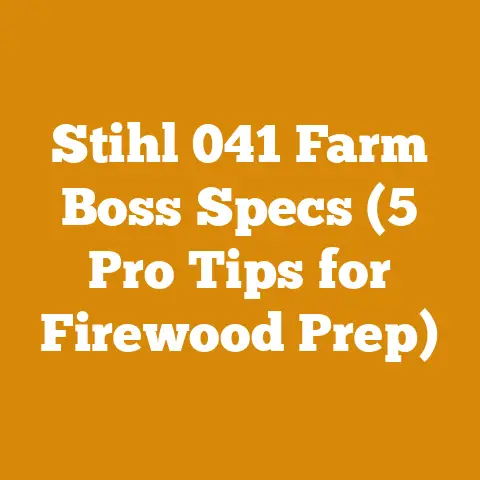How to Open Flue on Wood Stove (5 Pro Tips for Efficient Draft)
Here’s your article:
The opportunity to maximize the efficiency of your wood stove and reduce smoke is within reach.
A properly opened and maintained flue is crucial.
I’ll guide you through the essential steps and pro tips to achieve an efficient draft, ensuring a warmer home and a cleaner environment.
How to Open Flue on Wood Stove: 5 Pro Tips for Efficient Draft
As someone who’s spent countless hours felling trees, processing wood, and relying on wood stoves for heating, I understand the importance of a well-functioning flue.
I remember one particularly cold winter where a poorly opened flue nearly led to a house full of smoke and a severely inefficient burn.
That experience taught me invaluable lessons about flue management that I’ll share with you.
An efficient draft is not just about convenience; it’s about safety and maximizing the heat output from your firewood.
Understanding the Basics of a Wood Stove Flue
Before diving into the specifics, let’s clarify what a flue is and why it’s so vital.
The flue, often part of the chimney, is the passage through which combustion gases escape from your wood stove.
A properly opened and functioning flue creates a draft, drawing air into the stove to fuel the fire and expelling smoke and gases out of your home.
- What is a flue? It’s the channel, usually within your chimney, that vents smoke and combustion gases.
- Why is it important? Crucial for efficient burning, prevents smoke buildup, and reduces the risk of carbon monoxide poisoning.
- Components: Damper, chimney liner, and sometimes a barometric draft control.
A blocked or improperly opened flue can lead to several problems, including:
- Smoke Backdraft: Smoke entering your home instead of exiting through the chimney.
This happened to me once when a bird built a nest in my chimney. - Inefficient Burning: Reduced airflow to the fire, leading to incomplete combustion and wasted fuel.
- Creosote Buildup: Increased creosote accumulation in the chimney, raising the risk of chimney fires.
- Carbon Monoxide Poisoning: A potentially deadly risk if exhaust gases cannot escape properly.
Takeaway: A clear understanding of the flue’s function is the foundation for effective wood stove operation.
Pro Tip 1: The Initial Flue Opening Procedure
The first fire of the season, or any time the stove hasn’t been used for a while, requires a specific procedure.
This is to prime the flue.
Cold flues can be resistant to establishing a draft.
- The “Warm-Up” Fire: Start with a small fire using crumpled newspaper or kindling.
- Why it Works: The small fire warms the air in the flue, creating a slight updraft.
- Procedure: Place the kindling in the firebox, open the damper fully, light the kindling, and observe the smoke.
It should be drawn up the chimney.
If not, repeat with a slightly larger kindling fire. - Alternative: Use a propane torch to gently warm the flue for a few minutes.
Be extremely careful and avoid overheating the metal.
I’ve found that a few sheets of newspaper and some dry kindling are usually sufficient.
However, in very cold climates, a propane torch can be a faster method, but exercise extreme caution.
Takeaway: Priming the flue with a small fire is crucial for initiating a strong draft.
Pro Tip 2: Damper Positioning for Optimal Draft
The damper is the primary control for regulating airflow through the flue.
Its position directly affects the intensity of the fire and the efficiency of combustion.
- Fully Open: Use this position when starting a fire or adding fresh wood to the stove.
This provides maximum airflow for rapid ignition and combustion. - Partially Closed: Once the fire is established, gradually close the damper to reduce airflow and slow down the burn rate.
This conserves fuel and extends burn times. - Too Closed: Closing the damper too much restricts airflow, leading to smoldering, incomplete combustion, and increased creosote buildup.
I typically start with the damper fully open until the fire is roaring, then gradually close it down to about halfway for a steady, efficient burn.
The exact position will depend on the wood type and the desired heat output.
Hardwoods like oak and maple can tolerate a slightly more closed damper than softwoods like pine.
Takeaway: Mastering damper control is key to efficient wood stove operation.
Experiment to find the optimal setting for your stove and wood type.
Pro Tip 3: Monitoring and Adjusting the Draft
An efficient draft isn’t a “set it and forget it” situation.
It requires ongoing monitoring and adjustment based on various factors.
- Visual Cues: Observe the smoke coming from the chimney.
A thin, wispy smoke indicates efficient combustion.
Thick, dark smoke suggests incomplete burning and a need for more airflow. - Fire Behavior: A lively, dancing flame indicates good airflow.
A sluggish, smoldering fire suggests restricted airflow. - Weather Conditions: Changes in temperature, wind, and barometric pressure can affect the draft.
Colder temperatures and higher wind speeds generally increase the draft, while warmer temperatures and lower wind speeds can reduce it. - Wood Moisture: Wet wood requires more airflow to burn efficiently.
I often check the chimney smoke every hour or so, especially during the initial stages of a burn.
If I see dark smoke, I’ll open the damper slightly to increase airflow.
I also pay attention to the sound of the fire.
A healthy fire has a distinct crackling and roaring sound.
Takeaway: Regular monitoring and adjustment of the draft are essential for maintaining efficient combustion and preventing problems.
Pro Tip 4: Maintaining a Clean Chimney
A clean chimney is paramount for a safe and efficient draft.
Creosote, a byproduct of incomplete combustion, accumulates in the chimney and can significantly reduce airflow and increase the risk of chimney fires.
- Creosote Formation: Creosote is formed when unburned wood particles and gases condense in the chimney.
Factors contributing to creosote buildup include burning wet wood, restricted airflow, and low flue temperatures. - Chimney Sweeping: Regular chimney sweeping is essential to remove creosote buildup.
The frequency of sweeping depends on the amount of wood burned and the type of wood. - Professional vs.
DIY: You can sweep your chimney yourself with the right tools and knowledge, or you can hire a professional chimney sweep.
I prefer to hire a professional for a thorough inspection and cleaning. - Signs of Creosote Buildup: Reduced draft, black or brown flakes falling from the chimney, and a strong, acrid odor when the stove is burning.
I typically have my chimney inspected and cleaned annually, even if I haven’t burned a large amount of wood.
It’s a small price to pay for peace of mind and safety.
A chimney fire is a terrifying experience I never want to repeat.
Takeaway: A clean chimney is crucial for a safe and efficient draft.
Schedule regular chimney inspections and cleanings.
Pro Tip 5: Addressing Common Draft Problems
Even with proper opening and maintenance, draft problems can still occur.
Here are some common issues and how to address them.
- Downdraft: Wind blowing down the chimney, causing smoke to enter the house.
This is often caused by nearby trees or buildings that disrupt airflow.- Solution: Install a chimney cap designed to prevent downdrafts.
Trim or remove nearby trees.
- Solution: Install a chimney cap designed to prevent downdrafts.
- Cold Chimney: A cold chimney can be resistant to establishing a draft, especially in cold weather.
- Solution: Use the “warm-up” fire technique described earlier.
Insulate the chimney to help retain heat.
- Solution: Use the “warm-up” fire technique described earlier.
- Air Leaks: Air leaks in the stove or chimney can reduce the draft.
- Solution: Seal any air leaks with high-temperature sealant.
Ensure the stove door is properly sealed.
- Solution: Seal any air leaks with high-temperature sealant.
I once had a persistent downdraft problem caused by a tall pine tree near my chimney.
After trying various chimney caps, I finally had to trim the tree to solve the issue.
It’s important to identify the root cause of the problem and address it directly.
Takeaway: Identifying and addressing common draft problems is essential for maintaining efficient wood stove operation.
Choosing the Right Firewood
The type of firewood you use significantly impacts your wood stove’s efficiency and draft.
- Seasoned Wood: Always use seasoned (dried) wood.
Green wood contains a high moisture content, which reduces heat output and increases smoke and creosote buildup.- Moisture Content: Aim for a moisture content of 20% or less.
Use a moisture meter to check the moisture content of your firewood. - Seasoning Time: Allow firewood to season for at least six months, preferably longer.
Stack the wood off the ground in a well-ventilated area.
- Moisture Content: Aim for a moisture content of 20% or less.
- Wood Type: Hardwoods like oak, maple, and birch burn longer and produce more heat than softwoods like pine and fir.
However, softwoods ignite more easily, making them good for kindling.- BTU Content: Hardwoods generally have a higher BTU (British Thermal Unit) content per cord than softwoods.
This means they produce more heat when burned.
- BTU Content: Hardwoods generally have a higher BTU (British Thermal Unit) content per cord than softwoods.
- Wood Size: Use appropriately sized pieces of wood for your stove.
Overly large pieces may not burn completely, while overly small pieces may burn too quickly.- Splitting: Split firewood to the appropriate size for your stove.
Aim for pieces that are 4-6 inches in diameter.
- Splitting: Split firewood to the appropriate size for your stove.
I prefer to burn a mix of hardwoods and softwoods.
I use softwoods to get the fire started quickly and then switch to hardwoods for a longer, more sustained burn.
I always check the moisture content of my firewood before burning it.
Takeaway: Using seasoned hardwoods of the appropriate size is crucial for efficient wood stove operation.
Wood Processing Techniques for Optimal Burning
How you process your wood also impacts its burn quality.
I’ve learned a few tricks over the years that make a big difference.
- Splitting: Splitting wood not only makes it easier to handle and stack, but it also speeds up the drying process.
- Tools: Use a maul, splitting axe, or log splitter to split wood.
I use a hydraulic log splitter for larger logs. - Technique: Aim for straight splits along the grain of the wood.
Avoid twisting the splitting tool, as this can lead to jams.
- Tools: Use a maul, splitting axe, or log splitter to split wood.
- Stacking: Proper stacking allows for good airflow, which is essential for drying.
- Method: Stack wood in rows, leaving space between each row for air circulation.
Elevate the wood off the ground to prevent moisture absorption. - Orientation: Orient the wood so that the cut ends are exposed to the sun and wind.
- Method: Stack wood in rows, leaving space between each row for air circulation.
- Drying: The drying process reduces the moisture content of the wood, making it burn more efficiently.
- Duration: Allow wood to dry for at least six months, preferably longer.
Check the moisture content with a moisture meter. - Location: Store wood in a sunny, well-ventilated location.
Cover the top of the woodpile to protect it from rain and snow.
- Duration: Allow wood to dry for at least six months, preferably longer.
I always split my wood as soon as possible after felling the tree.
This allows it to dry more quickly.
I stack the wood in a sunny location with good airflow, and I cover the top of the pile to protect it from rain.
Takeaway: Proper wood processing techniques, including splitting, stacking, and drying, are essential for optimal burning.
Safety First: Essential Precautions
Working with wood and fire involves inherent risks.
Safety should always be your top priority.
- Personal Protective Equipment (PPE): Wear appropriate PPE when felling trees, processing wood, and operating a wood stove.
This includes safety glasses, gloves, hearing protection, and sturdy footwear. - Chainsaw Safety: If using a chainsaw, follow all safety guidelines.
Wear a chainsaw helmet with face shield and ear protection, chainsaw chaps, and gloves. - Fire Safety: Keep a fire extinguisher readily available near the wood stove.
Install smoke detectors and carbon monoxide detectors in your home. - Chimney Safety: Have your chimney inspected and cleaned regularly.
Be aware of the signs of creosote buildup.
I always wear safety glasses and gloves when handling wood.
I also keep a fire extinguisher near my wood stove and test my smoke detectors regularly.
I once witnessed a chainsaw accident that reinforced the importance of PPE.
Takeaway: Prioritize safety when working with wood and fire.
Use appropriate PPE, follow safety guidelines, and be aware of potential hazards.
Advanced Techniques for Maximizing Efficiency
For those looking to take their wood stove efficiency to the next level, here are some advanced techniques.
- Barometric Draft Control: A barometric draft control automatically adjusts the draft based on changes in atmospheric pressure.
This can help maintain a consistent draft and improve efficiency. - Catalytic Combustor: A catalytic combustor is a device that reduces emissions and increases efficiency by burning off unburned gases and particles.
- Wood Gasification: Wood gasification is a process that converts wood into a combustible gas.
This gas can then be burned in a specialized stove or furnace.
I have experimented with a catalytic combustor in my wood stove and found that it significantly reduced emissions and increased heat output.
However, these advanced techniques can be more expensive and require more maintenance.
Takeaway: Advanced techniques like barometric draft control, catalytic combustors, and wood gasification can further improve wood stove efficiency.
Troubleshooting Common Wood Stove Issues
Even with the best preparation, you might encounter issues with your wood stove.
Here’s a quick troubleshooting guide:
- Smoke in the House: Check the flue for obstructions, ensure the damper is fully open when starting the fire, and warm up the flue if necessary.
- Fire Won’t Start: Use dry kindling, ensure adequate airflow, and check the moisture content of the wood.
- Fire Burns Too Quickly: Close the damper slightly, use larger pieces of wood, and ensure the stove door is properly sealed.
- Fire Smolders: Open the damper more, use drier wood, and check for air leaks in the stove or chimney.
I once spent an entire afternoon trying to get a fire started in my wood stove only to discover that a squirrel had built a nest in the chimney.
It’s important to be patient and methodical when troubleshooting wood stove issues.
Takeaway: Knowing how to troubleshoot common wood stove issues can save you time and frustration.
The Future of Wood Heating
Wood heating is a sustainable and renewable energy source, and ongoing research and development are leading to even more efficient and cleaner wood stoves.
- Improved Stove Designs: New stove designs are incorporating advanced combustion technologies to reduce emissions and increase efficiency.
- Automated Controls: Some stoves now feature automated controls that adjust airflow and fuel feed based on temperature and other factors.
- Sustainable Forestry Practices: Sustainable forestry practices ensure that wood is harvested in a responsible manner, preserving forests for future generations.
I am optimistic about the future of wood heating.
With continued innovation and responsible forest management, wood stoves can play a significant role in providing clean and sustainable energy.
Takeaway: The future of wood heating is bright, with ongoing innovation leading to more efficient and cleaner wood stoves.
Conclusion: Mastering the Art of the Flue
Opening and maintaining a wood stove flue for efficient draft is an art and a science.
By following these pro tips, you can ensure a warmer home, a cleaner environment, and a more enjoyable wood-burning experience.
Remember to prioritize safety, use seasoned wood, and maintain a clean chimney.
With a little practice and attention, you can master the art of the flue and enjoy the warmth and comfort of a wood stove for years to come.
Now, go forth and conquer that flue!






